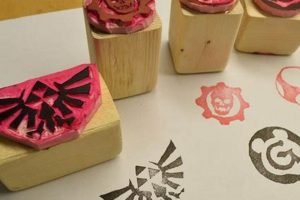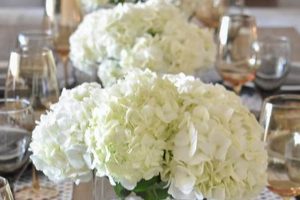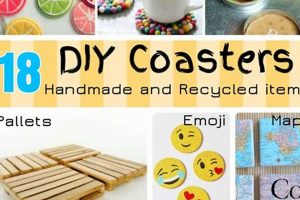Constructing personalized receptacles for floral displays allows individuals to exercise creativity while providing a tailored environment for plant growth. These handcrafted containers, often built from repurposed materials, offer an alternative to commercially manufactured pots. For example, an old wooden crate can be transformed into an attractive setting for herbs or annuals through the addition of a liner and drainage holes.
The practice offers several advantages, including cost savings and environmental responsibility through the reuse of discarded items. Furthermore, the ability to customize size, shape, and aesthetic ensures that the planters complement specific architectural styles or garden designs. Historically, the creation of containers for plants represents a connection between functionality and decorative arts, extending back to ancient civilizations utilizing terracotta vessels.
The subsequent sections will explore various material choices, construction techniques, and design considerations for creating successful and aesthetically pleasing containers. Detailed guidance will be provided on selecting appropriate materials for weather resistance, implementing effective drainage systems, and decorating the finished product to enhance its visual appeal.
Essential Tips for Constructing Custom Plant Receptacles
Achieving optimal results when building personalized containers for plant cultivation requires careful consideration of design, materials, and environmental factors. The following points offer guidance for ensuring the longevity and functionality of these handcrafted horticultural elements.
Tip 1: Material Selection is Paramount. Prioritize weather-resistant materials such as treated lumber, composite decking, or durable plastics. Untreated wood will degrade rapidly when exposed to moisture and soil.
Tip 2: Implement Adequate Drainage. Proper drainage is critical to prevent root rot. Incorporate multiple drainage holes in the base of the container and consider adding a layer of gravel or broken pottery shards at the bottom to facilitate water flow.
Tip 3: Use a Liner to Protect the Container. A plastic liner prevents soil from directly contacting the container material, extending its lifespan. Ensure the liner also has drainage holes.
Tip 4: Select Appropriate Soil. Utilize a well-draining potting mix specifically formulated for container gardening. Avoid using garden soil, which can compact and impede drainage.
Tip 5: Consider Container Size Relative to Plant Size. Choose a container that is appropriately sized for the mature size of the plants to be grown. Undersized containers can restrict root growth and lead to nutrient deficiencies.
Tip 6: Reinforce Structural Weak Points. When repurposing materials, reinforce any weak points with additional supports, screws, or adhesive to ensure structural integrity.
Tip 7: Apply a Protective Coating. Apply a sealant or paint specifically designed for outdoor use to protect the exterior of the container from weathering and UV damage.
By adhering to these guidelines, the constructed receptacles will provide a stable and healthy environment for plant growth, resulting in vibrant and flourishing displays.
The final section will offer aesthetic considerations for the created plant features to ensure the container matches the overall home and garden design.
1. Materials
The selection of appropriate construction components is paramount to the functionality and longevity of self-made receptacles for floral cultivation. Material properties directly influence a container’s resistance to environmental stressors, its ability to retain moisture without fostering decay, and its overall structural integrity.
- Weather Resistance
Exterior grade materials mitigate degradation from moisture, UV radiation, and temperature fluctuations. Untreated lumber, for instance, rapidly deteriorates when exposed to soil and rain, necessitating the use of treated alternatives, composite decking, or naturally durable options such as cedar or redwood. The selection dictates maintenance frequency and overall lifespan.
- Structural Integrity
The chosen material must withstand the weight of the soil, plants, and retained water. Thin plastics or brittle materials may crack or deform under load, leading to potential collapse. Solid wood, reinforced concrete, or metal frameworks offer superior structural support for larger or heavier plantings.
- Moisture Permeability
The material’s ability to manage moisture impacts root health. Highly porous materials may dry out too quickly, requiring frequent watering. Conversely, impermeable materials can lead to waterlogging and root rot if drainage is inadequate. A balance between water retention and drainage is crucial.
- Environmental Impact
Material selection can align with sustainability goals. Repurposing reclaimed wood, using recycled plastics, or opting for sustainably harvested lumber reduces environmental impact compared to using newly manufactured or non-renewable resources. Material sourcing should consider the ecological footprint of the finished product.
Therefore, the careful assessment of material characteristics, considering both functional requirements and environmental implications, is a foundational element in the successful creation of long-lasting and effective floral containers. The right choice ensures the plant bed resists wear and tear from the surrounding landscape and helps it stay together so plants can thrive.
2. Drainage
Effective drainage is a critical determinant in the health and longevity of plants cultivated within self-constructed receptacles. The ability to manage water effectively within the container environment directly impacts root health, nutrient availability, and overall plant vitality. Inadequate drainage creates conditions conducive to anaerobic soil environments, fostering root rot and hindering nutrient uptake.
- Preventing Root Rot
Excessive moisture surrounding plant roots deprives them of oxygen, leading to the proliferation of anaerobic bacteria and fungal pathogens. These organisms attack and decompose root tissue, causing root rot. The inclusion of drainage holes, typically at the base of the container, allows excess water to escape, mitigating the risk of this destructive process.
- Maintaining Aeration
Plant roots require oxygen for respiration, a fundamental metabolic process. Saturated soil impedes oxygen diffusion, suffocating roots and impairing their ability to absorb nutrients. Proper drainage ensures adequate aeration, allowing roots to thrive and function efficiently. The size and number of drainage holes should be commensurate with the container size and the water-holding capa
city of the soil. - Controlling Soil Moisture Levels
Different plant species exhibit varying tolerances to soil moisture. Some prefer consistently moist conditions, while others thrive in drier environments. Effective drainage allows for precise control over soil moisture levels, accommodating the specific needs of the plants being cultivated. Using a well-draining potting mix in conjunction with adequate drainage further enhances moisture management.
- Preventing Salt Buildup
Irrigation water often contains dissolved salts. In the absence of adequate drainage, these salts can accumulate in the soil, reaching toxic levels that inhibit plant growth. Excess water moving out of the bottom of the container, through drainage holes, leaches accumulated salts from the soil, preventing their buildup and maintaining a healthy soil environment.
Therefore, incorporating appropriate drainage mechanisms into the creation of self-constructed horticultural vessels is not merely an ancillary consideration but a fundamental requirement for fostering healthy plant growth and preventing detrimental soil conditions. For example, a succulent planter lacking drainage will quickly lead to root rot, whereas a moisture-loving fern will thrive with proper water outflow, if the vessel is in direct sunlight.
3. Size
The dimensions of a self-constructed receptacle for floral cultivation exert a significant influence on plant health, growth potential, and overall aesthetic harmony within a landscape design. The internal volume dictates the root system’s capacity for expansion and nutrient acquisition. Insufficient space restricts root development, leading to stunted growth, nutrient deficiencies, and an increased susceptibility to environmental stressors such as drought or temperature fluctuations. Conversely, an excessively large container, particularly for smaller plant varieties, can retain excessive moisture, predisposing the roots to rot and creating an imbalance in the soil ecosystem. As an example, a miniature rose planted in a very large container will tend to develop fewer blooms as its root system focuses on expansive growth rather than flower production.
Optimal sizing considers the mature dimensions of the intended plant species, accounting for both above-ground foliage and below-ground root mass. Furthermore, container depth influences soil temperature and moisture retention. Deeper receptacles provide greater insulation against temperature fluctuations and reduce the frequency of watering, proving advantageous in hotter climates or for species requiring consistently moist soil. The physical size also affects portability; large planters require more effort to move and reposition, impacting design flexibility. The sizing of the planter must match the specific type of vegetation. Tomato plants, for example, need large pots to have enough roots, compared to flowers that have smaller root systems.
Therefore, the careful determination of dimensions is essential for achieving horticultural success and aesthetic integration. Appropriately sized containers promote robust root development, optimize nutrient and water uptake, and contribute to a balanced and visually appealing landscape design. Overlooking this factor can compromise plant health and detract from the overall aesthetic impact of the planted feature. The selection should find a balance between the size of the plant’s root system and the surrounding design.
4. Durability
Durability is a key attribute of self-constructed horticultural containers, impacting their lifespan, performance, and overall value. The inherent ability of a planter to withstand environmental stressors, physical impacts, and material degradation directly determines its usefulness over time. Compromised durability necessitates frequent repairs or replacements, increasing maintenance costs and potentially disrupting plant growth. Choosing robust materials and construction techniques are crucial for enhancing longevity.
The connection between durability and homemade plant receptacles is evident in the impact of weather exposure. Unprotected wood, for example, will rot and decay under consistent moisture, whereas reinforced concrete or treated lumber exhibit greater resilience. Proper construction techniques, such as using weather-resistant fasteners and sealants, further enhance resistance to degradation. For example, the failure to adequately seal joints in a wooden planter will lead to water penetration and eventual structural failure. A plastic planter subject to UV exposure will often become brittle and crack.
Ensuring structural soundness, resistance to material decay, and stability are essential components of designing homemade plant beds that are able to survive. Therefore, durability represents a fundamental design parameter that directly influences the long-term success and cost-effectiveness of self-constructed horticulture containers. Overlooking this aspect can result in premature failure, increased maintenance expenses, and a diminished return on investment.
5. Aesthetics
Aesthetic considerations are integral to the successful integration of self-constructed floral receptacles into a designed environment. The visual appeal of the planter directly impacts its ability to complement surrounding architectural styles, landscape features, and plant selections. Disregarding aesthetic principles can result in a discordant element that detracts from the overall visual harmony.
- Material Palette and Texture
The choice of materials profoundly influences the visual character of the planter. Natural materials, such as wood or stone, impart a rustic or organic aesthetic, whereas metal or concrete can evoke a more modern or industrial sensibility. Texture, whether smooth or rough, adds visual interest and tactile appeal. Mismatched materials can clash with the surrounding environment, while a cohesive palette creates a unified and pleasing visual effect. For example, a rough-hewn cedar planter complements a cottage-style garden, while a sleek stainless-steel container suits a minimalist urban setting.
- Color Harmony and Contrast
Color plays a critical role in visual perception and can either unify or disrupt a design. The planter’s color should harmonize with the colors of the surrounding architecture, landscaping, and plant foliage. Contrasting colors can be used strategically to create visual interest or highlight specific features, but excessive contrast can be overwhelming. The chosen color should also consider its ability to withstand fading or discoloration from sunlight exposure. For example, bright colors may fade faster than more muted tones.
- Form and Proportion
The shape and size of the planter relative to the surrounding elements are crucial for achieving visual balance. A planter that is too large or too small can appear awkward or out of proportion. The form should also complement the architectural style of the surrounding buildings. A tall, narrow planter may suit a contemporary home, while a wide, low planter complements a ranch-style house. Geometric forms project a sense of order, while organic forms create a more natural and relaxed aesthetic.
Surface Embellishments and Detailing The addition of decorative elements can enhance the visual appeal of the planter and personalize its design. Surface embellishments, such as mosaics, carvings, or paint finishes, can add visual interest and texture. The level of detailing should be appropriate for the overall style of the design. Excessive detailing can appear cluttered or overwhelming, while minimal detailing creates a more understated and elegant look. For example, adding decorative tiles to a concrete planter can create a Mediterranean-inspired aesthetic.
These aesthetic elements contribute to the creation of self-made horticultural containers. The integration of the planter with the architectural style can be a benefit; from a metal planter contrasting a modern home or a wooden planter blending into a traditional garden, these all are aesthetic benefits that enhance any DIY flower planters. The combination promotes the overall success and creates an appealing and visually harmonious landscape.
Frequently Asked Questions
The following section addresses common inquiries and concerns regarding the creation and maintenance of self-constructed receptacles for floral displays. The responses are intended to provide clear, concise information for successful implementation.
Question 1: What is the optimal material for a flower container designed for outdoor use in a region with harsh winters?
Durable, weather-resistant materials, such as treated lumber, high-density polyethylene (HDPE), or powder-coated metal, are recommended for regions with harsh winters. These materials exhibit resistance to cracking, warping, and degradation from freezing temperatures and moisture exposure. Terra cotta, while aesthetically pleasing, is prone to cracking in freezing conditions and may require indoor storage during winter months.
Question 2: How can adequate drainage be ensured in a container constructed from a repurposed object lacking pre-existing drainage holes?
Drilling drainage holes is essential. The quantity and diameter depend on the size of the container. As a general guideline, drill several holes with a diameter of at least 0.5 inches in the base. Adding a layer of gravel or broken pottery shards at the bottom can further facilitate drainage and prevent soil from clogging the holes. Elevating the container slightly above the ground also aids drainage.
Question 3: Is it necessary to use a liner inside a wooden container?
The use of a liner is highly recommended. A liner prevents direct contact between the soil and the wood, prolonging the lifespan of the container by minimizing moisture absorption and preventing rot. Liners constructed from polyethylene or landscape fabric are suitable options. Ensure the liner also has drainage holes to allow excess water to escape.
Question 4: What type of soil is best suited for use in plant receptacles?
A well-draining potting mix specifically formulated for container gardening is recommended. Avoid using garden soil, as it tends to compact and impede drainage. Potting mixes typically contain a blend of peat moss, vermiculite, and perlite, providing optimal aeration and water retention. Adjustments may be necessary based on the specific needs of the plants being cultivated.
Question 5: How does the size of the container impact plant growth?
The container size must be proportionate to the mature size of the plant. Insufficient space restricts root growth, leading to stunted development and nutrient deficiencies. An excessively large container can retain too much moisture, fostering root rot. Research the mature dimensions of the intended plant species and select a container that provides adequate space for root expansion.
Question 6: What are the best methods for protecting homemade plant containers from the elements?
Applying a protective coating, such as a sealant or paint specifically designed for outdoor use, is crucial for shielding containers from weathering and UV damage. Periodic reapplication may be necessary to maintain optimal protection. Additionally, placing containers in sheltered locations during extreme weather events can further prolong their lifespan.
In summary, careful material selection, drainage implementation, soil selection, appropriate sizing, and protection from the elements are key factors in the successful creation and maintenance of self-constructed receptacles for floral displays.
The subsequent section will provide information on maintenance tips for the receptacles.
DIY Flower Planters
The preceding exploration has illuminated critical aspects of crafting personalized receptacles for floral cultivation. Emphasis has been placed on material selection, drainage implementation, appropriate sizing, structural durability, and aesthetic integration. Each element contributes significantly to the long-term health and visual appeal of the planted feature. A thorough understanding of these facets is essential for achieving successful horticultural outcomes and creating visually harmonious landscape designs.
The creation of personalized floral containers represents a confluence of practical gardening skills and artistic expression. When properly executed, this practice enhances environmental stewardship through material repurposing and fosters a deeper connection to the natural world. Continued exploration and refinement of construction techniques will undoubtedly yield innovative and sustainable solutions for enhancing the aesthetic and ecological value of cultivated spaces.







